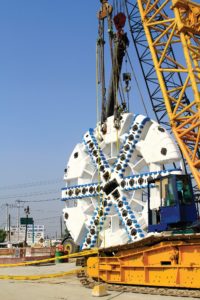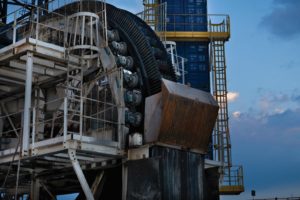![65 Years of Innovation and Experience [default]](https://www.robbinstbm.com/wp-content/uploads/2017/04/Side-Bar-Blue-Blocks_70-Years.jpg)
A Solution for Every Condition: Search our Project Database
Project Map
FEATURED PRODUCT: CROSSOVER MACHINES
Our History
A Legacy of Innovation
Information 24/7
News & Media
Insights in the Industry:
Read the Robbins Blog
 In an urgent effort to prevent flooding in the urban capital of Mexico City, the National Water Commission (CONAGUA) has ordered the construction of a 62 km (39 mi) long wastewater line, Emisor Oriente, which is expected to help increase Mexico City’s wastewater capacity and ease some of the city’s related problems. Torrential rains and continuing floods in Mexico’s capital during the rainy season have increased the urgency of the job, quickly making it the country’s most critical infrastructure project.
In an urgent effort to prevent flooding in the urban capital of Mexico City, the National Water Commission (CONAGUA) has ordered the construction of a 62 km (39 mi) long wastewater line, Emisor Oriente, which is expected to help increase Mexico City’s wastewater capacity and ease some of the city’s related problems. Torrential rains and continuing floods in Mexico’s capital during the rainy season have increased the urgency of the job, quickly making it the country’s most critical infrastructure project.
The Emisor Oriente project was divided into six lots – Lots 1, 2 and 5 awarded to Mexican contractor Ingenieros Civiles Asociados (ICA), S.A. de C.V., Lots 3 and 4 to Carso Infraestructura y Construcción, S.A. de C.V., and Lot 6 to Lombardo Construcciones and Constructora Estrella. Three 8.93 m (29.3 ft) Robbins Earth Pressure Balance Machines (EPBs) are excavating Lots 1, 3, 4, and 5 of the tunnel.
Mexico City is located in the Valley of Mexico. The area contains an ancient, drained lake bed and is surrounded by volcanic mountain ranges. The soil is mainly made up of watery clays running up to 80 m (263 ft) deep with the water table just 2 to 3 m (6.6 to 9.8 ft) below the surface. The ground also contains boulders up to 600 mm (24 in) in diameter. Due to the complex ground conditions, engineers believed for years that the ground would be too difficult to excavate. Despite the challenging terrain, Mexico City’s main wastewater line, Emisor Central, was hand-mined in 1964 approximately 100 m (328 ft) below ground, paving the path for future underground construction projects.
The Robbins EPBs were designed for the particularly difficult ground conditions they would be facing on the job site. Although difficult ground was anticipated, shaft excavations in 2009 and 2010 revealed much more complex terrain than originally expected, resulting in various modifications on each machine. The EPBs were built with mixed-ground, back-loading cutterheads with carbide cutter bits to deal with variable ground conditions, and ribbon-type screw conveyors to remove large boulders. Redesigned pressure bulkheads were added to the machines to accommodate the higher water pressures of the region, and enhanced wear detection was added to the cutter bits to ensure optimal performance. Robbins continuous conveyors are being used behind each machine in order to quickly remove muck from the jobsite and minimize downtime. Each continuous conveyor system and vertical belt is installed once the machines have bored ahead 150 m (492 ft) from their launch points.
One Robbins EPB was launched for Lot 1 on July 13, 2011 – a change from its originally scheduled tunnel drive at Lot 5. A flood at Lot 1 delayed the Herrenknecht machine that was originally designated to bore the area for six months, prompting the contractor to begin boring with the Robbins EPB. The machine started excavation at shaft 5 of Lot 1 using umbilical cables connected to the surface and a sludge pump for muck removal.
Excavation at Lot 1 was fast-tracked because of problems with Mexico City’s main open sewer line, the Gran Canal. The canal was constructed in 1910 and floods its banks on a regular basis, causing road closures and significant health problems to the city’s residents. The canal has a positive vertical alignment, resulting in potentially large volumes of water that could overload current pumping stations and send untreated water back into the city. The canal’s slope loss is due to the area’s sinking lake clays. To help remedy this problem, a treatment plant and pumping station are being constructed in shaft 5 of Lot 1 so water diverted from the section of the Gran Canal to Emisor Oriente can be pumped back into the Gran Canal where the slope has not been compromised. Although there were many challenges the first EPB machine had faced, it was able to make a successful breakthrough 15 months later. Once the Robbins EPB had bored its 4.6 km (2.9 mi) drive to shaft 3A of Lot 1, it was dismantled, removed, reassembled at Lot 5, and began boring its original 8.6 km (5.3 mi) long bore in early 2014.
 The remaining two Robbins EPBs started excavation in 2012, working on 9.2 km (5.7 mi) and 10.2 km (6.3 mi) drives at Lots 3 and 4, respectively. Once excavation was initiated, the machines quickly encountered sections of abrasive basalt rock and ash, boulders and blocky ground that wore on cutting tools and the cutterhead. As a result, the harsh ground conditions led to accelerated wear and damage on some of the cutting tools as well as the screw conveyors.
The remaining two Robbins EPBs started excavation in 2012, working on 9.2 km (5.7 mi) and 10.2 km (6.3 mi) drives at Lots 3 and 4, respectively. Once excavation was initiated, the machines quickly encountered sections of abrasive basalt rock and ash, boulders and blocky ground that wore on cutting tools and the cutterhead. As a result, the harsh ground conditions led to accelerated wear and damage on some of the cutting tools as well as the screw conveyors.
In efforts to manage the sudden impact of the challenges faced and to maintain control of the situation, the operational parameters at Lots 3 and 4 became a high priority. Improvements to the cutter change time on the central disc cutters were made possible with the design of a new rotary union. To reduce the abrasive wear on the cutterhead, more durable face and gauge scrapers were added to the cutterhead.
The Lot 3 machine underwent additional changes after boring 2.7km (1.6 mi) of its tunnel. The machine was given a new cutterhead fitted with chromium carbide wear plates and smaller openings to reduce blockages. The machine also get a new screw conveyor design with special wear plates, and a reinforced casing with additional gates and injection ports.
At Lot 4, the other Robbins Machine has fared better in soft rock, despite having a lot of water pressure to deal with—the machine even holds the shift record for the project, of 28 rings.
 The Lot 5 Robbins machine, which came from Lot 1, needed major modifications before starting at Lot 5 to help deal with expected water pressures up to 7 bar. The TBM—launched from the deepest shaft at a civil works project in Mexico (150 m)—was fitted with new hyperbaric chambers, as well as a new gantry for the compressors and air tanks. To speed up disc changes at the center of the cutterhead, the rotary union was also modified.
The Lot 5 Robbins machine, which came from Lot 1, needed major modifications before starting at Lot 5 to help deal with expected water pressures up to 7 bar. The TBM—launched from the deepest shaft at a civil works project in Mexico (150 m)—was fitted with new hyperbaric chambers, as well as a new gantry for the compressors and air tanks. To speed up disc changes at the center of the cutterhead, the rotary union was also modified.
On May 23, 2019, the last of the six 8.93 m EPBs completed tunneling at Lot 4 of Emisor Oriente, thus ending a ten year campaign of nearly 63 km of tunneling in some of the most arduous conditions crews have ever come across.
With the tunneling complete, the secondary lining operation also had to take place from the various headings using telescopic forms. The tunnel was opened for use in December 2019.

 Close
Close